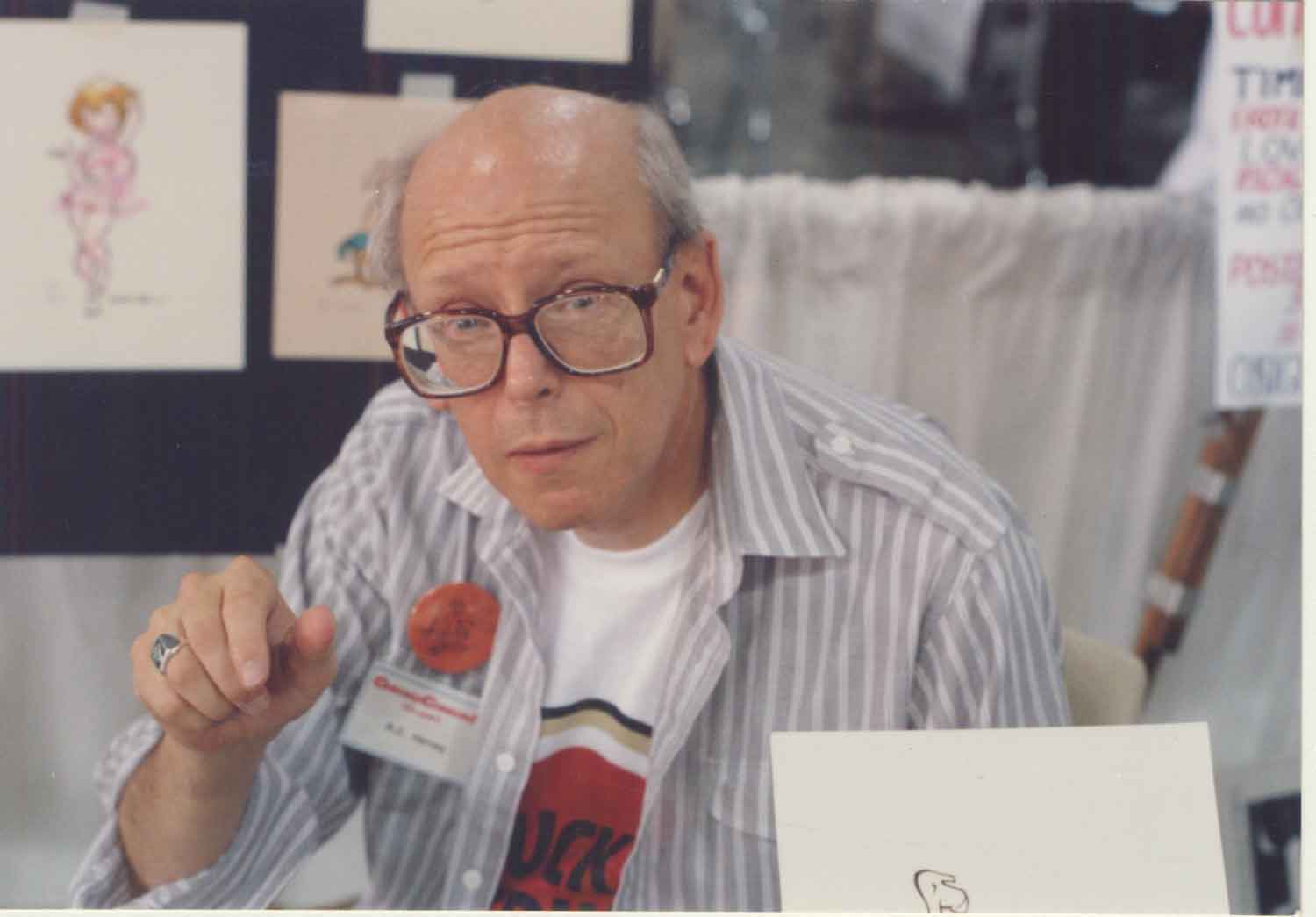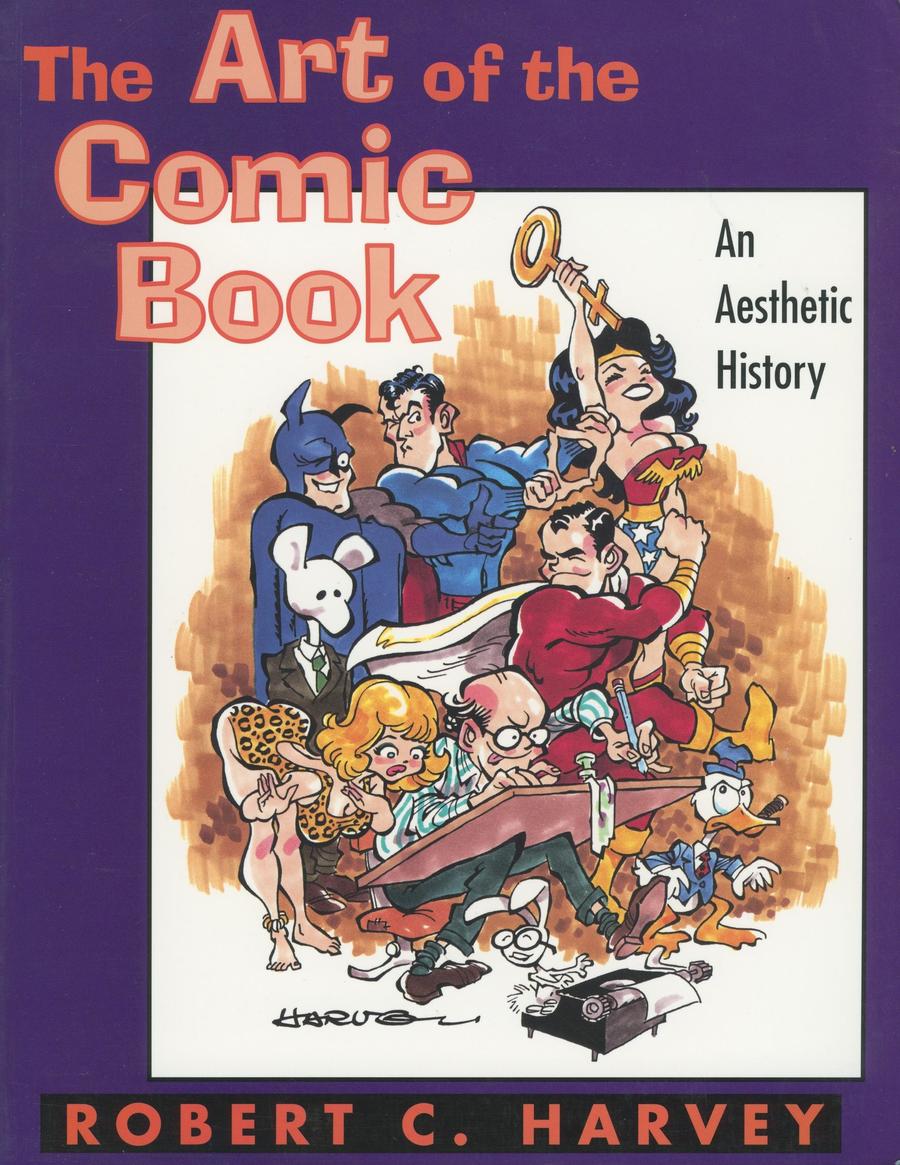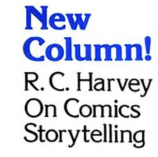
Robert C. Harvey, a longtime contributor to The Comics Journal and one of the industry’s most enduring, prodigious and personably provocative commentators on comics culture, passed away July 7 at the age of 85 due to complications from a fall. For more than five decades, “Happy Harv” helped to determine, and sometimes define, the myriad discourse surrounding comics professionals, fans, teachers and scholars. His contributions include seminal works of history and criticism; a number of landmark interviews and biographies of leading creators including Milton Caniff, Charles Schulz, Bill Watterson and Aaron McGruder; and a wide variety of edited collections, archival compilations and curated exhibits. All told, Harvey leaves behind an unequalled oeuvre of thousands of separately published articles, blog posts, columns, prefaces, commentaries and small-press pamphlets spanning every facet of cartooning and comic books. Aside from his voluminous writings, those who were fortunate to know him personally are especially saddened by the loss of his uniquely witty repartee, enthusiastic opinions on art and culture, and his eternally perspicacious perspectives on the comics multiverse.

Harvey was widely respected for his astute, often blustery blend of journalism, criticism, history and theory relating to just about every idiom of comics language. His central proposition that comics are defined by their unique properties of verbal-visual blending was widely considered and debated. Like other essential pioneers of comics studies, Harvey produced historical recuperations of key creators and influential comic strips alongside landmark works by Bill Blackbeard, Denis Gifford and Ron Goulart. He also promoted the serious archival acquisition and scholarly curation of comics and other multimodal narrative forms with longtime associates Lucy Sheldon Caswell, Randy Scott and Karen Green. Like John Lent, Donald Ault and M. Thomas Inge, Harvey further encouraged the first serious academic inquiry into comics studies and helped to elevate not only the art form, but also the critical discourse that debated its merits. His friends, colleagues and collaborators number in the thousands and include a veritable who’s who of leading scholars, collectors and advocates like Brian Walker, Maggie Thompson, Trina Robbins and Craig Yoe. A seasoned correspondent at the San Diego Comic-Con, the Chicago Comic Con, Fan Expo Denver and the annual meetings of the National Cartoonists Society, Bob charmed, sassed and snookered his way into many of the most important forums and consortiums in Comics. His continuous reports, reviews and opinions were highly regarded—and sometimes pointedly criticized—by readers worldwide. (A French comics historian once threatened to sue him over an unflattering review.)

An essential presence at the vanguard of comics studies and criticism, Harvey’s early chronicles like Children of the Yellow Kid (University of Washington Press, 1999), blended an enduring love for cartooning and cartoonists with intrepid criticism and dedicated detective work. Unlike many “first wave” fans and historians, however, Harvey was also a practicing cartoonist, who frequently poked fun at his own underwhelming commercial success as a slinger of strips, gags and comic book concepts. Harvey’s creative interests always informed his commitment to celebrating and supporting the craft of making quality comics. Few comics scholars, past or present, have developed such a substantial catalogue of work that delves so thoroughly into the lives, concerns and conflicts of creators - past and present, iconic and obscure. In fact, Harvey’s greatest gift to the medium may arise from the scores of fresh faces and forgotten talents that he encouraged, promoted, interviewed and recovered through his vast and varied “rants and raves.” Some of his best and most rewarding resuscitation work is highlighted in Insider Histories of Cartooning: Rediscovering Forgotten Famous Comics and Their Creators (University Press of Mississippi, 2014) as well as the hundreds of capsule biographies he produced for Oxford’s American National Biography and the dozens of interviews he developed for Jud Hurd’s Cartoonist PROfiles. "Bob was a devoted chronicler of his favorites," remarked author Bob Levin, himself a longtime Comics Journal contributor. "He loved cartoonists and the medium, and he seemed an indefatigable researcher in tracking down their work and documenting their lives. I always learned something from whatever he wrote, and I always looked forward to spotting his byline - sometimes with trepidation at how much free time it was going to cost me."

Much to his delight, his work frequently garnered criticism and sparked debate concerning his blatant preferences and bold presentiments relating to style, form and genre. Bob’s affably ornery attitudes were clearly derived from his enthusiastic love for the medium, its people and its potential. To that end, two of his most significant works include the Billy Ireland Cartoon Library-published compilation A Gallery of Rogues: Cartoonists’ Self-Caricatures (1998) and Harvey’s proudest effort, his Fantagraphics-published magnum opus biography of Milton Caniff, the tectonically-sized, 952-page Meanwhile... (2007). Both works derived from Harvey’s unequaled respect and regard by professional cartoonists themselves, who felt his work spoke accurately and honestly to their interests as artists, humorists and cultural critics.
 As a personal aside, it’s worth noting that the original manuscript for Meanwhile... ran for well over 1,700 pages. As the first “assistant” Harvey trusted to edit the text by nearly 50%, I can honestly say that the original project was an even more massive and meandering mastodon that spoke to his gregarious curiosity as a historian of media and culture as well as Caniff’s remarkable influence across every major element of early 20th century American life. As Bob and I often joked after his third martini and my fifth bourbon, it took him 10 years to write it and 3 years for me to ruin it so everybody could read it. For those very few masochists in need of more Meanwhile..., one extant copy of the titanic original is proudly archived at the Ohio State University’s Billy Ireland Library and Museum, where it sits atop an oversized platinum throne, guarded by several three-headed dogs, as Bob proudly boasted. With Meanwhile... especially, Harvey’s enduring friendship with Caniff himself informs every page, line and phrase with admiration for ground-breaking works like Terry and the Pirates, Steve Canyon and Male Call, as well as the 20th century comic strip’s transcendent cultural significance. Though Meanwhile... is easily—and sometimes rudely—criticized for its hefty girth and rampant editorializing, it is a genuine testament to the perseverance, popularity and importance of comics studies; that one of its most avid scholars could take the better part of 20 years to produce and publish a text of such critical (and literal) weight justly serves to confirm the value and influence of this grand master of newspaper adventure serials and the medium in which he worked. Similarly hefty tomes like David Michaelis’ Schulz and Peanuts and Michael Tisserand’s Krazy may owe some small acknowledgments to the outsized length and uncompromising breadth of Meanwhile...
As a personal aside, it’s worth noting that the original manuscript for Meanwhile... ran for well over 1,700 pages. As the first “assistant” Harvey trusted to edit the text by nearly 50%, I can honestly say that the original project was an even more massive and meandering mastodon that spoke to his gregarious curiosity as a historian of media and culture as well as Caniff’s remarkable influence across every major element of early 20th century American life. As Bob and I often joked after his third martini and my fifth bourbon, it took him 10 years to write it and 3 years for me to ruin it so everybody could read it. For those very few masochists in need of more Meanwhile..., one extant copy of the titanic original is proudly archived at the Ohio State University’s Billy Ireland Library and Museum, where it sits atop an oversized platinum throne, guarded by several three-headed dogs, as Bob proudly boasted. With Meanwhile... especially, Harvey’s enduring friendship with Caniff himself informs every page, line and phrase with admiration for ground-breaking works like Terry and the Pirates, Steve Canyon and Male Call, as well as the 20th century comic strip’s transcendent cultural significance. Though Meanwhile... is easily—and sometimes rudely—criticized for its hefty girth and rampant editorializing, it is a genuine testament to the perseverance, popularity and importance of comics studies; that one of its most avid scholars could take the better part of 20 years to produce and publish a text of such critical (and literal) weight justly serves to confirm the value and influence of this grand master of newspaper adventure serials and the medium in which he worked. Similarly hefty tomes like David Michaelis’ Schulz and Peanuts and Michael Tisserand’s Krazy may owe some small acknowledgments to the outsized length and uncompromising breadth of Meanwhile...
Of his many diversified projects, some of Harvey’s finest writing remains under-appreciated. His decade’s worth of attempts to report on the bitter feud between Ham Fisher (Joe Palooka) and Al Capp (Li’l Abner), aptly titled Hubris and Chutzpah: How Li’l Abner Kayo’d Joe Palooka and Both Their Creators Came to Grief was eventually serialized online through TCJ after years of rejections, but the devious deceptions of this true story of revenge and betrayal fascinated Harvey for years. Similarly, my favorite of his many critical works is not the Galactus-sized Meanwhile... or one of his many online reflections on the elegance of Brooks and Wiese’s Freddy the Pig stories (which he always championed). It is, instead, a privately-printed extension of his absolutely charming critical homage to Schulz’s Peanuts, entitled A Meditation on the Art of Cartooning and the Age of Schulz. This oversized 16-page reflection on the many timeless charms of Schulz’s views on children, adults and beagles in all seasons shows Harvey as his insightful, erudite and energetic best as a writer, critic and enthusiast. It includes not only a capsule history of Peanuts itself, but also brief, elegant musings on each iconic character, and a sidebar yarn about Harvey meeting Schulz in his Santa Rosa studio that also speaks beautifully to all who knew or felt they knew both men. I teach it in several courses on comics, popular culture and critical analysis, and students are consistently struck by its loving flow and its author’s perceptive regard for the simple, timeless qualities of great comics. I would give everyone I know a copy if I could. That’s probably not possible, but for those who want to savor a bit more of Bob’s buoyant brand of comics journalism in the fairly near future, please check out his collaboration with the filmmaker Tom Tanquary in the 2020 documentary Hand Drawn Life: The History and Influence of Newspaper Comic Strips. Finally, Bob has left us one last gift of colossal comics criticism. His long-anticipated The Art of Popeye: A Masterwork of the Medium will arrive posthumously this November from Hermes Press, a fittingly super-charged finale to a career of rare and welcome productivity.

Finally, it’s appropriate to acknowledge that R.C. Harvey was very well-regarded by his peers, fans and fellow funny men. His awards and accolades are considerable, including the 2013 Association of American Editorial Cartoonists’ Ink Bottle Award and the 2018 San Diego Comic-Con International Inkpot Award for contributions to the world of comics. He also contributed an essay to the Eisner-winning 2008 collection Little Nemo in Slumberland: Many More Splendid Sundays. In truth, Harvey appreciated the praise and recognition, especially his early accolades, such as a Certificate of Merit from Scholastic Magazines as a high school senior and the honor of earning All-Navy Cartoonist in 1960, but Bob was never a man to seek simple, officious validation. He always preferred a great story, a good drink and interesting company. I and several of my cartooning companions including Damian Duffy and John Jennings were fortunate to have enjoyed many such meetings with him, and while comics communities will mourn his passing, I am deeply saddened that his slick wit, quick smile and rich laughter are now lost to us all. In honor of his joyful demeanor, I would rather end with a laugh than a tear, so here is one my favorite stories about the wonderful luck I had to be Bob Harvey’s pal.
In early 2003, Bob and I were enjoying one of our many rainy afternoon sojourns through his seemingly limitless archive of interviews, artifacts and ongoing projects in Champaign, Illinois. Many moons before, he had converted his garage into a cozy sort of studio/library/Wunderkammer that was absolutely supersaturated with every form of cartoon object, icon and idol. To be fair to Bob’s myriad interests, there were also copious volumes on journalism, advertising, ethics, political economy and psychology with a few random naturalist and ecologist magazines throw in for good measure. It was a truly cosmic confabulation of treasures and thrills, but my favorite quadrant was the far corner where his plentiful files of original comic strip art were enshrined in a massive, fireproof horizontal file. Every once in a while we would hit the drawers and pull out a special item to savor together.
In those days, everyone was crazy for Frank Cho’s Liberty Meadows. The syndicated strip and the Insight/Image title were going gangbusters. Some of this success had come from Bob’s hearty endorsement of Cho’s considerable gifts for gag construction and his gregarious linework. He was especially glad that the strip blended both human and animal comedy so seamlessly, though Bob admitted that he was always a bit disappointed that Cho had decided to change frantic Frank from a duck to a human when he developed Liberty Meadows from its original college newspaper incarnation, University². Still, Harvey promoted Cho’s abilities whenever he could. In gratitude, Cho had sent Bob a beautiful rendering of the entire Liberty Meadows cast complete with a beaming Brandy, a frustrated Frank, and a full complement of their anarchic animal friends. We studied the drawing for quite a while, remarking on Cho’s original pencil roughs and the clear, clean inking that followed as it fleshed out each figure.
At one point, the great Bob Harvey asked me to scrutinize Brandy’s ankles. I looked carefully, and they seemed just fine to me. Then he showed me a small erasure near the back of her heel, a line that almost anyone, professional or amateur, would hardly notice. It was probably less than 2 cm and barely more than a glace of the pencil. I smiled and said it looked like a minor glitch in the linework.
Bob let out his signature treble laugh and smiled. “Heh. Heh. Heh.”
Then he added, “I love this drawing but that darned extra line bothered me. It drove me crazy. I couldn’t stand it, so finally I got up in the middle of the night and I fixed it. I fixed Frank Cho! Now, how about that? Heh. Heh. Heh.”
Something about his impish satisfaction got me. We both broke down laughing, and after a few minutes, gladly slipped Bob’s amended Cho back into its vault.
As much as I have admired R.C. Harvey for the wisdom, wit and whimsy of his work, I will miss the honest humor of a great man who was dedicated to the art of comics with a passion for perfection that few of us will ever match.
So thanks Bob, for all of your comradery, comedy and correction of the things we love to read, draw and share.
Tonight, it’s all about suitably chilled martinis and perfectly rendered ankles in your memory.






